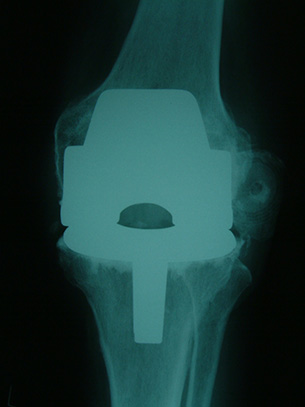
A complication of total knee replacement. The white lump on the outside of the knee joint (image’s right) is the patella (kneecap), which has dislocated post-operatively, and unexpectedly.
It is an unfortunate fact of life that not all operations go according to plan. Problems are rare but they can occur. Those associated with knee replacement fall into two categories:
1. Complications of surgery in general
2. Complications directly related to knee replacement
Complications of surgery in general
In reality these are more common, largely because of the age group involved - normally over 50 years. At such an age it is common to have associated diseases, be they cardiovascular, urinary, gastrointestinal, or others. Surgery can bring otherwise dormant conditions to the fore. The commonest is perhaps urinary retention, when a patient is unable to pass urine after surgery. This may require a catheter to be passed into the bladder for a few days. It is only rarely a long-lasting issue. The second commonest is perhaps deep-vein thrombosis (DVT), when blood clots form in the leg veins. A DVT can occasionally pose a risk to life, if a blood clot flies off and lodges in the lungs - pulmonary embolism. Fortunately this is rare.
Complications directly related to knee replacement
These are many and varied, and include the following:
Loosening
A knee replacement is a man-made device attached to living bone. As a consequence it is likely to loosen eventually. Figures are improving all the time, as they are with hip replacement, but it would be reasonable to say that approximately 8% of knee replacements will have loosened 10 years after surgery. Nothing, however well it is performed, is forever!
Bone Fracture
As the years go by, so the bone adjacent to a knee replacement thins and weakens. This is called loss of bone stock. The problem affects approximately 2% of knee replacements.
Infection
Infection in a knee replacement is a major problem. It may necessitate staged revision surgery, which is not always successful. Approximately 2% of primary knee replacements will become infected.
Instability
After knee replacement it is sometimes possible for the knee to feel 'wobbly' to a patient. In 1-2% of cases it may be necessary for a patient to wear a supportive knee brace. A revision operation cannot be excluded.
Patellar Dislocation
This occurs in 1% of patients after knee replacement. Small though the patella may be, the management of patellar dislocation after knee replacement can be challenging and may require revision surgery.
Failure of Wound Healing
This is always a worry and affects approximately 5% of patients. The knee replacement components are immediately under the skin and so can easily become exposed if a wound-healing problem is too severe. Plastic surgery, or revision surgery, may be needed.
Nerve Injury
Major nerve injury is rare at knee replacement, occurring in less than 1% of cases. However, the skin nerves are invariably affected. The majority, if not all, of knee replacement patients will note that the lateral (outer) part of the knee becomes numb following the procedure. This is not of functional consequence at all.
Post-operative Haematoma
A haematoma is a large collection of blood. It may be so tense that it can compromise wound healing. The blood also acts as a prime focus for infection. Bacteria love blood! Consequently, if a haematoma becomes a problem it is best drained as soon as possible.
Reduced Range of Movement
A replacement knee will most likely, after rehabilitation is complete, pass through a range of movement from straight to 110 degrees at least. The majority should certainly bend to a right angle. Occasionally stiffness occurs. If a joint cannot bend to at least a right angle, this can cause difficulties for the patient. A manipulation under anaesthetic (MUA) is then sometimes performed, but even this cannot always rectify the situation.
Rare Complications
This category includes component breakage, major blood vessel injury, component malposition, fat embolism, and dislocation. Fortunately these are all very rare, occurring in less than 1% of cases. In the case of major blood vessel injury, for example, the incidence is less than 0.03%!
